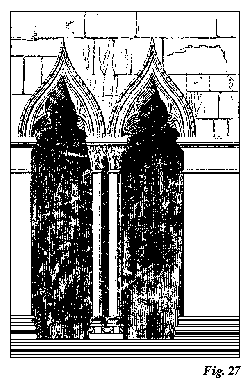148 THE STONES OF VENICE CONSTRUCTION
runs along the wall of the house is quite strong enough for the work of the capitals of the slender shafts: its own upper stone is therefore also theirs; its own lower stone, by its revolution or concentration, forms their bells: but to mark the increased importance of its function in so doing, it receives decoration, as the bell of the capital, which it did not receive as the under stone of the cornice.
In Fig. 28, a little bit 
This last arrangement is of great frequency in Venice, occurring most characteristically in St. Mark’s: and in the Gothic of St. John and Paul we find the two arrangements beautifully united, though in great simplicity; the string courses of the walls form the capitals of the shafts of the traceries, and the abaci of the vaulting shafts of the apse.
§ 25. We have hitherto spoken of capitals of circular shafts only: those of square piers are more frequently formed by the cornice only; otherwise they are like those of circular piers, without the difficulty of reconciling the base of the bell with its head.
§ 26. When two or more shafts are grouped together, their capitals are usually treated as separate, until they come
[Version 0.04: March 2008]